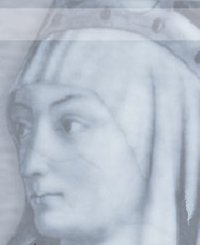
By Ruth Palmer
Sarra Copia Sullam was born to a prominent Italian Jewish family in Venice around 1592. Her parents were Simon and Ricca Copia, and her sisters were Rachel (Diana) and Esther (Ster). Sarra was educated in the basics of Jewish and Italian culture, and was most likely learned in several languages, including Hebrew, Latin, and Greek. She married Jacob Sullam, a prominent Jewish Venetian businessman, sometime between 1609 and 1612. They had no surviving children.
In 1618, Copia Sullam read L’Ester, an Italian drama by Ansaldo Cebà (1565–1623), a Genoese monk and author. In a letter, she professed to him her spiritual love for him and said that she slept with his book under her pillow and always carried it with her. Cebà wrote back with the wish to continue their correspondence, and also a desire to have her convert to Christianity. This would begin a long term correspondence between the two writers, during which they would exchange pictures, sonnets, and gifts. Though they never met, their communication became intimate, sometimes including allusions to courtship, romance, and sexuality. Despite his monasticism, Cebà wrote to her that like the two p’s in her name, Coppia, which means “couple,” in Italian, they could be a Christian couple together, presumably in heaven after their deaths. Copia Sullam immediately removed one p from her name, thereafter spelling it Copia or Copio. The spelling of both her first and family names tend to vary in different sources.
Copia Sullam has been connected with the Accademia degli Incogniti, a Venetian literary salon, because many of the men involved there in the 1630s were the same circle in which she herself was financially and intellectually involved in the 1620s. In fact, Cebà was included on the list of members of the Accedemia, though he died in 1623 and was from Genoa, which further insinuates Copia Sullam’s involvement in the salon.
Her circle included: Ansaldo Cebà; Numidio Paluzzi (1567–1625), a Roman writer and poet who taught her poetry and perhaps Latin; Alessandro Berardelli, a Roman painter, poet and close friend of Paluzzi; Baldassare Bonifacio (1586–1659), a poet, priest and legal scholar, who was also in correspondence with Paluzzi; Giovanni Basadonna; Giovanni Francesco Corniani (1581–1646), a writer, poet and public official, who served as a member of the Esecutori contro la bestemmia (prosecutors of blasphemy) and the Avogaria del commune (board of state attorneys); perhaps Giovanni Maria Vanti (d. 1641), a priest and writer; and Leon Modena (1571–1648), a rabbi, writer and Jewish scholar who had close connections with her family.
However, many of those close to her would betray her later. In June 1621, Baldassare Bonifacio published a treatise, Immortalità dell’anima (On the Immortality of the Soul), in which he accused Copia Sullam of heresy, stating that she did not believe in this dogma, which is basic to both Judaism and Christianity. In response, she wrote Manifesto di Sarra Copia Sulam hebrea Nel quale è da lei riprovate, e detestata l’opinione negante l’Immortalità dell’Anima, falsemente attribuitale da SIG. BALDASSARE BONIFACIO (The Manifesto of Sara Copia Sulam, a Jewish woman, in which she refutes and disavows the opinion denying immortality of the soul, falsely attributed to her by Signor Baldassare Bonifacio). Copia Sullam defended her views and attacked Bonifacio’s assertions and methods in Manifesto, and the work was published in three different editions the first year by the same publisher as Bonifacio’s.
Copia Sullam would send a copy of Manifesto to Cebà, to which he did not reply for seven months and then without sympathy for her. Their relationship became unfriendly before he died, and he chose to end their correspondence.
She was also accused by her former teacher, Paluzzi, of having stolen his writings, including the Manifesto, one of the sonnets in it, and two no longer existing “books of paradoxes praising women and condemning men.” Paluzzi published these accusations in a pamphlet co-written by Berardelli, called Le Satire Sarreidi. Berardelli echoed the claims of plagiarism in an introduction to a collection of Paluzzi’s poetry, Rime del Signor Numidio Paluzzi all’illustre ed eccellentissimo Signor Giovanni Soranzo, in 1626. The claims were widely believed, even though they directly contradicted those of Bonifacio, who previously accused Copia Sullam of plagiarizing the work of a rabbi in writing the Manifesto.
Though neither of the publications of accusation against Copia Sullam survived, in 1987, Carla Boccato published a manuscript of an anonymous author, which makes indirect references to the defense of Copia Sullam, written in the form of a story of a trial on Mount Parnassus before Apollo. This manuscript, calledCodice di Giulia Soliga or Avvisis di Parnaso, references factual accounts of the Venetian criminal trial, draws upon several unpublished sonnets by Copia Sullam, and has her defense spoken by some of the most famous literary Italian women in history: Vittoria Colonna, Marchesa of Pescara and one of the first published women poets (1492–1547); Veronica Gambara of Correggio, another early woman poet (1485–1559); and the comic Isabella Andreini of Padua (1562–1604). Also included are Sappho of Lesbos and Corinna.
Selected Works:
Reale Simioli, Carmela. “Tracce di letteratura ligure (1617–1650) nelle carte napoletane dell’Archivio Dorio d’Angri.” Accademie e biblioteche d’Italia 49 (1981): 321–339. (Archivio di Stato di Napoli, Archivio da Marcantonio Doria, fs. 688, fol. 12a), contains one letter by Sara Copia Sullam.
Sullam, Sara Copia. Sonetti editi e inediti raccolti e pubblicati insieme ad alquanti cenni biografici. Ed. Leonello Modona (Bologna: 1887), 21–27. Contains many of her sonnets.
Cebà, Ansaldo. Lettere d’Ansaldo Cebà scritte a Sara Copia. Ed. Marcantonio Doria (Genoa: 1623). Contains four of her sonnets.
Boccato, Carla. “Sara Copia Sullam: La poetessa del ghetto di Venezia: episodi sua vita in un manoscritto del secolo xvii.” Italia 6 (1987): 104–218. Contains five of her sonnets as well as the Codice di Giulia Soliga/Avvisis di Parnaso.
Manifesto di Sarra Copia Sulam hebrea Nel quale e` da lei riprovate, e detestata l’opinione negante l’Immortalità dell’Anima, falsemente attribuitale da SIG. BALDASSARE BONIFACIO (Venice: 1621), published in three editions. Contains four sonnets. Usually bound with Bonifacio’s Risposte, which contains a letter from her.
Gabriel Zinano. Rime diverse. (Venezia: 1627). Contains one of her sonnets.
Bibliography:
Carla Boccato, published an important series of articles on Sarra Copia Sullam in La Rassegna mensile di Israel(In Italian):
- “Un episodil della vita di Sara Copia Sullam: Il Manifesto sull’Immortalita` dell’Anima.” La Rassegna mensile di Israel39 (1973): 633–646.
- “Lettere di Ansaldo Cebà, genovese, a Sara Copia Sullam, poetessa del Ghetto di Venezia.” La Rassegna mensile di Israel40 (1974): 169–191.
- “Un altro documento inedito su Sara Copia Sullam: il ‘Codice de Giulia Soliga.’” La Rassegna mensile di Israel 40 (1974): 303–316.
- “Nuove testimonianze su Sara Copia Sullam.” La Rassegna mensile di Israel46 (1980): 272–287.
- “Il presunto ritratto di Sara Copia Sullam.” La Rassegna mensile di Israel52 (1986): 191–204.
- “Una disputa secentesca sull’immortalità ell’anima, contributi di’archivio.La Rassegna mensile di Israel 54 (1988): 593–606.
- Harrán (ed.), Jewish Poet and Intellectual in Seventeenth-Century Venice: The Works of Sarra Copia Sulam in Verse and Prose Along with Writings of Her Contemporaries in Her Praise, Condemnation, and Defense(Chicago: University of Chicago Press, 2009).
- Harrán, “Doubly Tainted, Doubly Talented: The Jewish Poet Sara Copia (d. 1641) as a Heroic Singer.” inMusica franca: Essays in Honor of Frank A. D’Accone, ed. Irene Alm (Stuyvesant, NY: Pendragon Press, 1996), pp. 367–422.
Corinna da Fonseca-Wollheim, “Faith and Fame in the Life and Works of the Venetian Jewish Poet Sara Copia Sullam (1592?–1641)” (Thesis submitted for the degree of Doctor of Philosophy, Faculty of Modern and Medieval Languages, Cambridge University, no date, 1999?).
Corinna da Fonseca-Wollheim is a music critic in New York City and a regular contributor to the Wall Street Journal.
Lynn Lara Westwater, “The Disquieting Voice: Women’s Writing and Anti-Feminism in Seventeenth-Century Venice” (Thesis for PhD in Department of Romance Languages and Literatures at the University of Chicago, 2003).
Helen Leneman, “The Venetian Ghetto of the 17th century ; its place in Jewish history, and one of its most unique products: Sara Coppio Sullam” (Master’s Thesis–Hebrew Union College-Jewish Institute of Religion, Los Angeles, Edgar F. Magnin School of Graduate Studies, 1986.)
Helen Leneman is an independent scholar, singer and pianist living in Bethesda, Maryland. Special interests include musical interpretations of biblical women’s narratives. Her book, The Performed Bible: The Story of Ruth in Opera and Oratorio (Sheffield Phoenix) was published in 2007.
Tags: Age of Discovery, Baroque, Europe, Poets, Religious Thinkers, Writers
